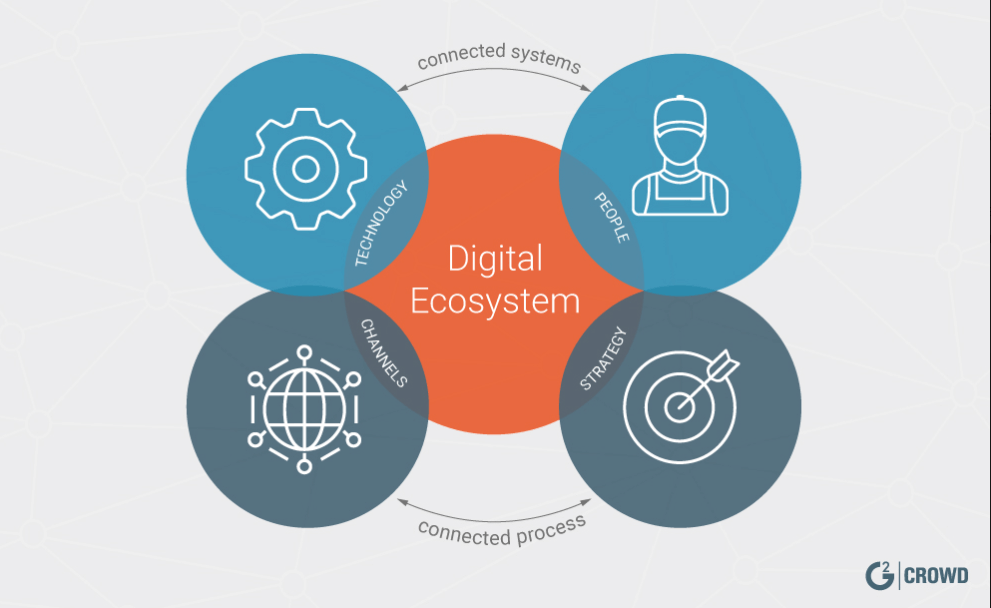
Can Your Technology Vendor Survive in Your Digital Ecosystem? How to Find a Partner that Breathes Life into Your Transformation Strategy
A watch, a computer, and a phone all walk into a ba…..
An office. A watch, a computer, and a phone all walk into an office.
They each exist and serve their own functions individually. But they’re compatible, too. They talk to each other to form their own little digital ecosystem. The watch shares messages and fitness data with the phone and the computer. The phone shares calls with the computer and the watch (And occasionally rings through your computer speakers in meetings. It’s fine).
Not only that, but each of these devices forms an even larger ecosystem with neighboring devices. When one of my coworkers tries to connect to Wi-Fi using a device in the Apple ecosystem, my phone prompts me to share the Wi-Fi password over to them.
In seconds, these smart devices remove the need to search for information. They create a pathway for knowledge-sharing that’s quick and effective.
Top-performing companies are turning to digital ecosystems for closer collaboration and communication. The little ecosystem living on my desk is an incredible representation of how well technology can work to streamline processes, share information, and improve teamwork.
“Each new digital ecosystem is a unique animal, like a Mr. Potato Head of carefully selected parts that serve a purpose both on their own and together. They allow businesses to move faster, maximize productivity, and minimize on-premises investments and liabilities.” – What is a Digital Ecosystem? Bridging Gaps for Tech by Andrew Zangre for G2
Why do digital ecosystems matter to my contact center? We’re not a business giant like Apple.
In 2018, more than 50% of digital transformation efforts stalled out completely, and customer experience fell flat. Companies are failing at digital transformation because they don’t have the technology, processes, or collaboration they need to change for their customers.
Legacy technology and siloed systems shackle your contact center to old processes and immovable platforms that can’t shift with your company’s changing needs.
But digital ecosystems offer up the power and connection to remove the shackles.
Here’s how our friends over at G2 define digital ecosystems.
Digital ecosystems are made up of companies, people, data, processes and things, all connected by the shared use of digital platforms.

In layman’s terms, digital ecosystems are how companies and people use technology to improve teamwork, data sharing, and streamline how we work. These ecosystems can exist within a company, like connecting all your technology across departments to work better together. Or, they can exist outside of your company’s walls. With third-party vendors and partner businesses to skyrocket your chance of success.
After all, the more collaboration and brainpower backing your business goals, the better.
In fact, almost 80% of the world’s top-performing companies are a part of a digital ecosystem. And fewer than half of companies with average performance have made the leap to an ecosystem structure.
Your vendors can breathe new life into your digital transformation strategy by building up your ecosystem. Or, they can be the unforeseen predator who limits your future.
Sometimes, your technology and existing partnerships hold you back. Vendors that don’t work for you squash your contact center of its revenue earning potential.
To step beyond the 50% of companies who failed at digital transformation last year, you need business partners who fit into your ecosystem and who bring you into theirs.
How to choose a vendor that breathes life into your digital transformation strategy.
Think long term.
Nearly 93% of companies say they need innovation technologies to reach their digital transformation goals. You can’t transform your business and build a digital ecosystem without the right technology (or without the right people and partners). Legacy tools and outdated solutions were built for 20th-century problems. They weren’t designed to handle the problems that pop up with 21st-century customers and employees.
Your outdated platforms won’t have the inherent flexibility you need to change schedules at a moments’ notice. Like when your agents are late for work. They won’t let you re-route calls to different team members when you’re in a pinch. And, they certainly won’t let you route a mindfulness or coaching lesson to an agent’s queue to get their day back on track.
How can a platform that hasn’t evolved much since the 90s know how to predict scheduling the night after the new Stranger Things season drops on Netflix?
You may have a few stragglers “stuck in traffic” that day. (We’re only kidding. You keep your agents engaged, so they’ll be punctual.)
But really, how will your outdated platform monitor Twitter for all the customers who keep tagging your company in Tweets, hoping someone will rush to their rescue? With tools invented well before Twitter, and companies trying their best to play catch up, the internet will flood with negative mentions of your brand before your agents ever set eyes on the issue.
Think long-term when looking for a vendor partner. Be growth-minded and ask your vendors how they’ll support you now, and how they’ll shift with you to support you 10 years from now, too. Choosing a vendor that’s fit to scale and change rapidly ensures you have a partner to grow with you, not be the ol’ ball and chain that holds you back.
Ask the right questions.
Evaluate how each potential partner will help you meet your contact center and business goals. Ask questions to see how each vendor can support you today. And, probe to see how each vendor will look at your business proactively, too. Will they think up future questions and problems to solve for, or will they come to a halt when you talk about your lofty plans for growth?
Here’s a list of questions to ask as you start your conversations with potential vendor partners.
7 questions to ask yourself and company stakeholders:
- What specific problems do I need to solve in my contact center today? And how can software help fix them?
- What obstacles currently get in the way of great customer service?
- What does my interaction volume look like daily? How about during peak times and seasons?
- How do my customers like to communicate?
- Based on my ideal customer profiles, how might communication or their needs change in 5 years?
- What kind of customer data do I need to capture, keep, and use?
- What kind of performance data do I need to capture, keep, and use?
7 questions to ask vendors:
- Will I have to adapt my process to fit the technology’s limits?
- Do your tools integrate with the systems I already have in place?
- What does the implementation process look like? And, how does the number of seats I need impact these deadlines?
- How frequently can I contact customer support? And, what SLAs protect my contact center’s operations?
- How frequently do you push updates to the platform?
- Can I get product feedback back to the development team?
- Can you support my need to scale quickly without impacting quality?
Kick-off your vendor conversations with these questions to get your potential partner on board. Walk through your needs, your goals, and what you see changing in your contact center with time.
Want more questions to ask potential partners? Get our template with 101 questions to ask in your RFP when you evaluate contact center vendors.
Learn from other client use cases.
The best third-party partners will already have their own digital ecosystems in place. They’ll work with partner vendors, build custom APIs, and share functionality across the board with their clients. This existing ecosystem gives you access to new tools and use cases to streamline your contact center’s operations. Without starting from scratch.
Did one of your vendor’s client’s build a custom IVR? Is another beta testing a new feature? What integrations already exist? Look to your potential partners to learn how you can capitalize on what already exists in their own ecosystem.
Chances are, if a vendor built a customized integration or new feature for an existing client, they won’t keep it under lock and key. They’ll make it available to more contact centers and businesses that need it, too.
Push beyond the bounds of standardized functionality. Work with your partner vendors to solve problems specific to your contact center.
Just because a vendor doesn’t have the same feature set as your old platform doesn’t mean they can’t solve your problems.
In fact, they might even be able to do it better. With a new toolset and proven results.
Build the digital ecosystem that works for you, not the one that works for everyone else. The right digital tools and partners will drive your business forward and finally move the customer satisfaction needle.

